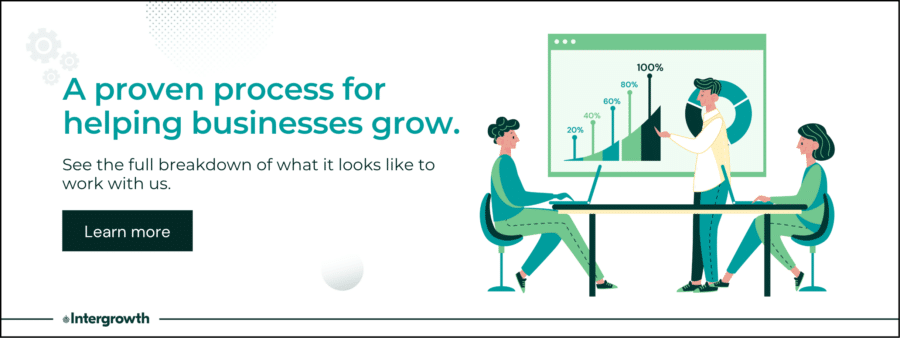As a content strategist, I help companies figure out what kinds of content they should publish online to connect with their target audience.
That’s the simplest way to put it.
There’s a lot more to the job, though. I’ll explain below. I hope it’s useful if you’re interested in working with or as a content strategist.
What Does a Content Strategist Do?
The exact responsibilities of a content strategist vary from company to company.
In a large corporation, your entire job might be to map out strategies and plan the editorial calendar. Those in smaller companies might create, edit, and promote content, too.
So, while I can’t speak to what everyone with this job title does, I can speak to my own job. My responsibilities include:
I’ll talk about what each of these entails below.
1. Brand Discovery With New Clients
We start every client relationship by learning about the client’s business and goals. We call this the “discovery” process.
In-house marketers work through a similar process with their company’s products. They spend a lot of time learning about what each product do and what makes it different from similar products.
During the discovery process, we learn as much as we can about the client:
- Ideal customer: Who is their target audience?
- Products/services: What problems do they solve for people?
- Revenue sources: How do they make money?
- Brand identity: How do they want the public to perceive their company?
- Brand voice: How do they want to “sound” to their audience?
- Company values: What is important to the company?
- History: When the company was founded, by whom, and how did it grow over time?
- Competitors: Who else offers similar products and targets a similar ideal client?
Working to understand the client’s business goals is an important step in this process, too.
Are they investing in content marketing services to promote a specific product?
Is their goal to increase online revenue, to encourage walk-in visits to their physical locations, or something else?
Where do they see the company in one year if they achieve their goals?
Whatever the case, this information helps us develop content campaigns that align with the client’s brand and target audience.
Note: Content strategists aren’t necessarily the only people conducting client discovery interviews. In many companies, that’s an account manager’s role. However, a good discovery interview is crucial to a great content marketing strategy. Whether they conduct the interview or not, strategists should always look for new questions to ask stakeholders during discovery.
2. Content Audits for New Clients
Before we start planning new content, we analyze all of the old and underperforming content on the client’s website (if they have any). Refreshing old content can often have a higher ROI than publishing new stuff, so we always try to incorporate some “content revamps” into our strategies.
We also look for opportunities to improve a client’s website SEO. Simple fixes like tweaking a website’s meta titles or restructuring the site’s navigation bar can make a website much more attractive to search engines, which can help the client’s content appear higher in Google searches. We present these proposed fixes to our new clients as part of the initial strategy we build for them shortly after partnering with us.
Learn more about our content review process.
3. Topic Analysis
Topic analysis is the part of content strategy where we think about how to reach the target audience.
What types questions are they asking online while thinking about making a purchase?
What types of questions are they asking before they even realize there’s a product that solves their problem?
What other types of content can we create for the audience that, even if it doesn’t aim to sell them anything, will help them to remember our client’s brand name?
As we work to answer these questions, we spend a lot of time analyzing competitor content. Watching what competitors publish online is critical in figuring out what our clients should publish. Understanding how customers arrive on a client’s website (i.e., which search terms lead them there) tells us a lot about what types of content our audience wants (and what they’re not getting).
For instance, let’s say we find that one piece of content on a competitor’s website drives 25% of their organic traffic. In that case, we’d want to create something about that same topic, as we already know that the target audience is interested. (Of course, we’d aim to make ours better and more valuable than our competitors’.)
Or, we might find a very short piece of content on a competitors’ website that only ranks high in search because no one else has covered that topic. Creating a longer, more informative resource about that topic will provide more value to the target audience and will likely outrank the competitors in search over time.
4. Editorial Planning
By this point, we’ve done our competitor analysis and identified all of the topics we want to create during the next few months. From there, we start to answer some important questions:
- What is the best form for each piece of content to take? Some topics are best covered by a blog post or case study, while others might require graphics, a video, or an interactive tool (such as a calculator).
- What is each piece of content’s purpose? Will it influence sales directly (encouraging people to buy) or indirectly (by establishing the brand as an authoritative and trustworthy name)?
- Who is the best person on our team to create each piece of content? We pair content writers with topics that match their experience.
- Who else needs to be involved? Do we need to interview a subject matter expert on our client’s team?
As we answer these questions, we start to prioritize content based on its relevance to the client’s goals. We’ll also map out a long-term editorial calendar that contains each piece of content’s title, author, publication, and more, along with a post description to help the client understand our plan.
This process involves a lot of collaboration with the client, who may have feedback about specific topics. In some cases, they may feel like a particular topic isn’t relevant to their brand, or they may have suggestions about making a piece of content more valuable to their audience.
5. Content Creation (or Managing Content Creators)
This is one area where the job description differs depending on the marketing team.
In a large corporation, the strategist usually isn’t involved in content production — they’re probably managing several campaigns at once and focus solely on strategy.
However, the strategist might be responsible for copywriting, video editing, or other content creation tasks in smaller companies. They may even play a role in publishing content to the client’s content management system.
Now, that’s not always the case. Some boutique marketing firms have a full-time staff of in-house writers, editors, and publishers. Others contract the work out to freelancers. But, if the strategist isn’t responsible for creating the content themselves, they probably work with or managing the people who do.
Related: Should I Hire a Marketing Agency or an In-House Marketer?
6. Project Tracking and Analysis
This is the most important step in any marketing campaign: review, tracking, and analysis.
We use tools like Google Analytics, Search Console, SEMRush, and Ahrefs to measure our content’s performance in search engines:
- How much organic traffic does each blog article drive to the website, and how has that changed over time?
- How much has revenue changed since we started publishing content on the client’s site?
- Which pieces of content attract the most buyers (whether they buy immediately or months down the line)?
Tracking SEO metrics like traffic, impressions, and conversions from the moment a piece of content goes live helps us understand how it is performing. When it starts to perform worse, we can make edits to improve it. If it exceeds our expectations, we can learn from it and apply what we learned to some of the underperforming pieces on a site.
While the exact role of a content strategist varies depending on the context, the goal is always to provide something valuable to the audience. Whether it’s a blog article comparing two similar products or one that answers a common customer question in depth, good content can help you establish trust with potential clients.
A content strategist’s job is to determine how a company can reach its target audience in order to increase brand awareness and drive sales over time. By identifying what types of content the audience needs and mapping out a plan for getting that content to them, the strategist can greatly impact a company’s growth.
Are you looking to hire a content strategy team? Let’s schedule a call and see if we can help.
SCALE YOUR ORGANIC TRAFFIC
Subscribe to our monthly newsletter




